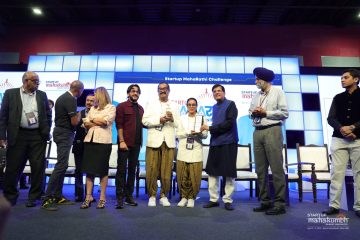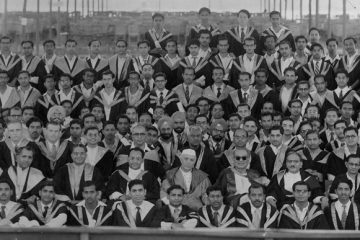 Summer is always a busy time at the M.N. Faruqui Innovations Centre. Established in 2014, the Centre is named after former Deputy Director and former faculty, Dr M.N. Faruqui, and seed-funded by the Institute’s distinguished alumnus Mr Arjun Malhotra, was conceived as a place where fresh undergraduate students could work, chat, discuss, and get hands dirty in the mechanical workshop or the wet lab setups. Students, even first year students, are encouraged to bring a project idea, have it ratified by some faculty, mentors and experts and then just begin experimenting to heart’s glory.
Summer is always a busy time at the M.N. Faruqui Innovations Centre. Established in 2014, the Centre is named after former Deputy Director and former faculty, Dr M.N. Faruqui, and seed-funded by the Institute’s distinguished alumnus Mr Arjun Malhotra, was conceived as a place where fresh undergraduate students could work, chat, discuss, and get hands dirty in the mechanical workshop or the wet lab setups. Students, even first year students, are encouraged to bring a project idea, have it ratified by some faculty, mentors and experts and then just begin experimenting to heart’s glory.

And they have, unfailingly. Prerit Gupta (2017/DD/CE) is one of the many who has worked at the Innovations Centre. Prerit used the facilities mostly in 2015-16. He was part of a three-member group working on ‘Autonomous Driving Guide’.
Prerit says, “We wanted to create a demo for cars – initially toy cars – through a combination of sonar and camera in order to give a 360 degree view to an autonomous vehicle so that it could gauge the distance of an obstacle. Most of the others work with LIDAR, which stands for Light Detection and Ranging, a remote sensing method that uses light in the form of a pulsed laser.”

Prerit and his team mates, one drawn from Mechanical Engineering, the other from Electrical Engineering, did not complete their project. But that is not so important. He says, “For young students like us, it is very difficult to get funds. But we were very excited to get the opportunity to tinker around and at the same time get guidance from the professors. We had keys to the laboratory and could walk in any time.”
The Innovations Centre comprises a Design Facility and Tinkering Laboratory. While the Design Facility is used for brainstorming and meetings, the Tinkering Lab has elaborate conferencing tools, 3D printers, a mechanical workshop with fabrication machinery, electronics workbenches, PCB fabrication set-ups, and prototyping tools for embedded systems, among others.

The idea was to train students in trans-disciplinary areas at early stages of engineering studies and promote the culture of innovation among a wide cross section of students and faculty with support from its alumni and the industry.
Prof. C.S. Kumar of the Department of Mechanical Engineering, who is in charge of the M.N.Faruqui Innovations Centre says, “The objective of this Centre was to provide tinkering facilities to students to motivate them to innovate through experimentation. Till date multiple student groups have sought funding from the Centre to develop innovative products in various domains.”

Some of these domains are Systematic electric power distributor to be used in urban poles, variable range rheostat, micro scale eco pad to facilitate adhesion of objects to various types of surfaces, Energicycle which assists ride with stored potential energy from braking, Suitcase that can be hauled up a staircase, Arsenic filter, clay pot refrigerator etc. With some additional support facilitated by Shri Bijoy Chatterjee, a group is also developing an electric vehicle with its own energy efficient motor control and battery management system.
Prof. Kumar says, “During the past year, one of the projects, namely the Energicycle, has filed a patent. The Centre also supported fabrication of parts for student teams participating in the Smart India Hardware Hackathon in June 2019 for rural technologies using its 3D printers and a PCB router that were made available.”

Anurag Goel, who will graduate from IIT Kharagpur in Instrumentation Engineering in 2019, used the MN Faruqui Innovations Centre, extensively for creating the prototype of the Energicycle. He worked with Hemant Kumar Chaudhury, a fifth year Dual Degree student of Biotechnology, on the project. The idea was proposed at the Open IIT Product Design contest in 2015. The team started work on the project in the 2016 summer. They stayed back during the vacation to work in the M.N. Faruqui Innovations Centre and eventually made the first prototype.
Anurag says, “We were greatly motivated by Prof. Kumar and first made CAD models which were tested. We then made a 3D printed model and next went to cycle shops in Kolkata to experiment the product. We made six different models of the cycle. One has been finalized and gone for patenting.”
 The Centre was recently visited by Ravi Kant, IIT KGP alumnus
The Centre was recently visited by Ravi Kant, IIT KGP alumnus
(BTech/MT/1966/NH) and former vice-chairman Tata Motors, who heard out students and reviewed the works in the facility during his campus visit in August 2018.
In addition, the Centre’s activities were reviewed by Arjun Malhotra during his annual visit at the time of Annual Alumni Meet in January 2019, and by Bijoy Chatterjee during his campus visit in February 2019. Talking about MNFIC, Mr Malhotra said, “Prof. Faruqui has been an inspiring figure. He would always pull me into some kind of a technical discussion to ensure that my ‘fundas’ were clear. For every problem he had a “holistic” approach to ensure that there was a solution that worked in the real world.
“To ensure that students learn, it is necessary to brainstorm together, to give them the support and the space so that they can freely ideate and freely experiment with those ideas.”
Graphics : Suman Sutradhar



